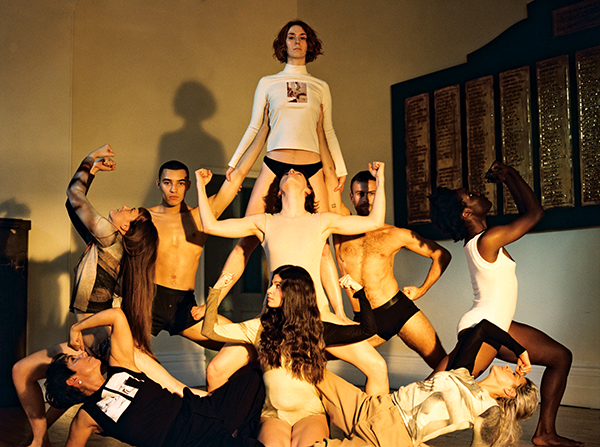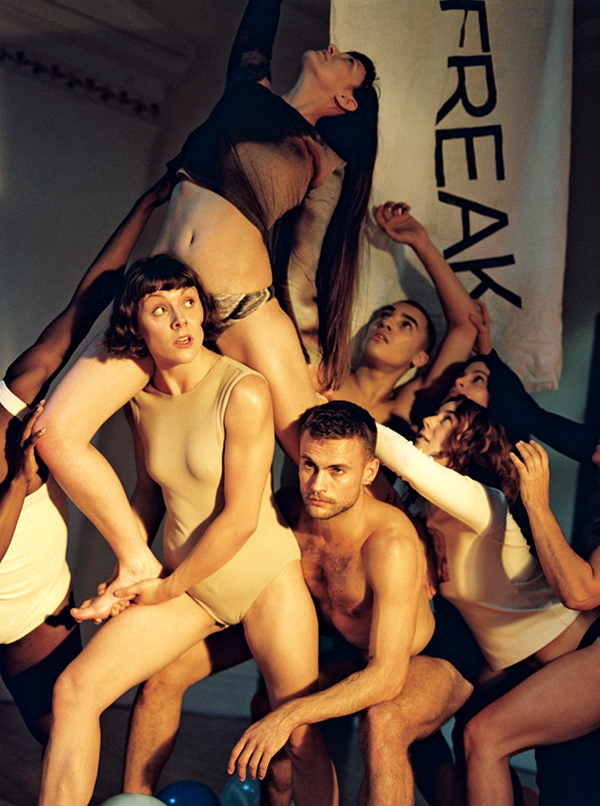A Serious Platform for Women
An Interview with Grace Nicol
BY EMMALY WIEDERHOLT
Grace Nicol is a London-based dance artist and choreographer who in 2017 launched Woman SRSLY, a platform for female identifying and socialized female artists. The interdisciplinary performances include dance, theater, music, live art, film and cabaret. Grace shares the impetus, goals and responses of Woman SRSLY.
Photography: Henry Gorse, Stylist: Patricia Villirillo, Makeup: Sarika Thakorlal, Performers: Woman SRSLY dancers
~~
How did you become interested in exploring movement through a socio-political lens?
It was a long time coming. The way I choreograph is very specific to the people I work with. I’m not keen on choreographers imposing their ideas on dancers’ bodies or using them as a tool, as an artist might use paint. It needs to be a symbiotic relationship between choreographer and performer. I like to work with very diverse casts of people – different ages, genders, backgrounds – to try to get different perspectives on the way I see something. My interest in exploring social and political matters came out of recognizing that my collaborators are like all people – inevitably and intrinsically connected to societal and political issues.
I didn’t come out of regimented training at all. I got my bachelor’s degree in choreography from Dartington College of the Arts. It was kind of a hippy school, teaching dancers to be creators rather than bodies. Its history includes brilliant creatives and choreographers such as Rudolf Laban, Emilyn Claid and Rosemary Butcher.
How did Woman SRSLY come about?
In London, it’s tough for all choreographers and dancers, but I noticed that it seems to be easier for male choreographers. I believe part of that comes from the perception that more women dance, so when boys are young, there’s a lot of separating them out and giving them special treatment. That attitude gets carried through to when they become professional; men are seen as special, women as part of the furniture.
I started questioning that. There needs to be a diverse range of voices in choreography. Once you get to the professional level, it’s harder for women. There have been a few festivals geared specifically for women, but they seem to be once a year or so. It’s like women can come into the space men usually occupy but only for that small point in time.
I was speaking with a friend who is a theater practitioner, Ursula Early, who had just started a new theater called CentrE17 with Max Peters. I mentioned it would be great to nurture a platform supporting female artists all year round. They liked the idea. I started by asking some like-minded friends to participate, because I wasn’t sure if it would be successful or not and, of course, we didn’t have any funding. It ended up being really well received; loads of people came. Woman SRSLY just grew from there. In August, it will be our first anniversary. We’re now at The Yard Theatre, and the support and interest has been overwhelming. I think it is indicative of how needed it is. We especially try to support people whose work has been overlooked in the past or who struggle to find support.
How is Woman SRSLY structured?
It started off being produced once every two months, but that was just too much to take on (the team was busy studying and making a living) so now it’s once every four months. We put out an open call so that we don’t just program people we know. Applicants must be female identifying or socialized female artists. By that, we hope to include gender queer and non-binary artists as well.
The number of participants per show varies. We try to have at least four acts a night, but we’ve had as many as seven when we haven’t been able to choose! We also have a bar in the lobby where we screen films, as well as happenings such as live installations and female DJs. We try to have new artists every time, but we continue to support the artists we’ve already worked with by writing references or suggesting them for other shows. For example, we recently programmed some artists for a Friday Late at the V&A Museum here in London. We try to continue to support our previous artists, as well as recruit new artists for the actual platform. We’ve had 18 ‘acts’ to date.
We choose participants via a panel, comprised of the same women, many of whom participated in the platform early on. I started the panel because I thought it was a bit limiting if it was just me deciding who got to show work every time. Like I said, with my own work, I like to have diverse voices at the table. The way the panel works is everyone selects three applicants, and then we look at the pool and see who fits together as the most exciting and cohesive program.
What kinds of responses has Woman SRSLY received, either from audience members or participants?
Obviously, the work can be quite delicate and need a lot of support, but our audiences have been lovely so far. We try to make the platform a safe space.
One woman made a piece about artists who have children and who are unable to find childcare while they are performing. For young mums, it can be difficult to continue a performance career. This artist had her baby asleep onstage the whole performance, and the audience just had to be quiet to avoid waking up her baby. We had a board in the lobby where audience members could write responses, and people wrote things like, “Loved it, made me laugh, can’t believe feminist baby stayed asleep the whole way through, congrats” or “So intelligent, I loved how you took over the theater and made us actively silent.”
In terms of feedback from the artists, we actively ask for this. We’re very aware that if we’re representing other people, we need to do it in a way that feels right for them. We’re very open to change and trying to make the platform better for everyone. One artist said, “Thank you so much for the energy, the kindness and the capacity for sisterhood, unity and strength. I felt it the whole evening and had not for such a long time!”
We recently applied for funding through Groundwork London and got it for the next platform on the 30th of August at The Yard! Within that funding, we created an access fund, so now participants can apply for money to help with concerns like childcare or accessibility needs. These particular needs came from the artists themselves telling us about the issues they face and suggesting how to make it better.
How have you navigated intersectional issues like racial representation?
To be completely honest, when we first started out, we did have predominantly young, Caucasian women taking part. We realized this was an issue straight away and got together as a team to discuss the different ways in which we could tackle this. Our team itself is very diverse in terms of race, background, age, sexual orientation, as well as artistic discipline, so we were able to collectively pool our thoughts about how to tackle this. I think it comes down to whether or not someone thinks the platform is for them, so it’s about placing importance on how people are represented.
Since we have made those changes and opened up the platform with the call, the applicant pool has opened massively.
Why is it important to create platforms for female-identifying and socialized female artists?
There’s been a lot of problematic discussion around female choreographers in England. A couple of years ago, choreographer Akram Kahn said, “We don’t need more female choreographers just for the sake of it.” Statements like that ignore the fact that there are female choreographers already, but they are just not getting the same support. Woman SRSLY is important because it’s saying we are here and we deserve the same support, recognition and platforms as our male counterparts.
As most people are aware, there has been a new upsurge in politics and the social sphere towards more feminist viewpoints. Art has always led political movements. It’s important for us to be involved, not only for the sake of the artists, but for the wider context.
What are some ways you’d like to develop Woman SRSLY in the future?
We hope to continue to grow as a platform involving more artists and finding innovative and open ways of supporting female identifying and socialized artists. Inevitably, I would like to change attitudes towards female artists and performers and try and contribute in some way to bridging that gap. I’m also really interested in learning how to do things better within Woman SRSLY itself and am open to hearing what the artists have to say and continuing to try and make those changes for the better.
Photography: Henry Gorse, Stylist: Patricia Villirillo, Makeup: Sarika Thakorlal, Performers: Woman SRSLY dancers
~~
To learn more, visit www.grace-nicol.com/woman-srsly


